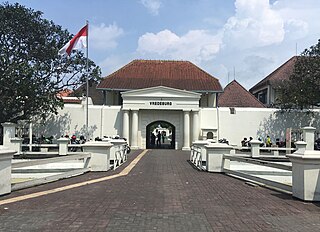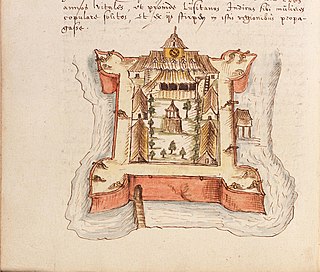
Fort Amsterdam (also formerly known as Blokhuis Amsterdam) is a fort and a blockhouse in Hila town, Leihitu Subdistrict, Central Maluku Regency, Ambon Island, Indonesia. The blockhouse was built in 1637 by the Dutch East Indies Company.

Fort Amsterdam (also formerly known as Blokhuis Amsterdam) is a fort and a blockhouse in Hila town, Leihitu Subdistrict, Central Maluku Regency, Ambon Island, Indonesia. The blockhouse was built in 1637 by the Dutch East Indies Company.
The blockhouse is a three-floored structure. It is roughly square in plan with area 16 x 16 m with 47 cm thick walls. [1] The interior is 4.57 x 5.3 m in size. Each side of the building contains a window, with a door on the eastern wall. The ground floor is covered with bricks, and contains a prison and a gunpowder magazine. The upper floor is wooden. The uppermost storey is roofed. The buildings contains two bastions in the northeast corner and southwest corner (seaward). One of the corner of the building contains a watchtower. [2]
The blockhouse is surrounded by a square-shaped defensive wall measuring 52 x 52 m. There are remnants of wall foundation measuring 62 x 35 m. The main gate is on the east side, while two smaller doorless gates is located to the north and to the south.

Before the fort was built, a trade lodge was established here by Francisco Serrão in 1512, a Portuguese explorer and a cousin of Ferdinand Magellan. [2]
In the 17th-century, the Dutch East Indies Company was formed and the Dutch colonize the entire island of Ambon. The lodge was converted into a defensive post. It is located in the northern coast of Ambon Island. Because of the local uprising led by Kapitan Kakialy between 1633 and 1654, the governor-general Jaan Ottens converted it into a defensive post in 1637 and was expanded by Gerrad Demmer in 1642 and by governor-general Anthony Caan in 1649. The fort was finalized by Arnold de Vlaming van Oudsthoorn from 1649 until 1656 and was named Fort Amsterdam. Rumphius, a great German botanist, lived in the fort from 1660 to 1670. [2]
The fort was left neglected by the Dutch in the early 20th century. A large tree had grow around it before the Indonesian Department of Education and Culture decided to restore it in July 1991. The restoration was based on a picture from François Valentijn's Beschreiving van Amboinan. [2]
The fort is not yet enacted as cultural heritage by the Directorate of Archaeological Heritage. [1]


South Maluku, also South Moluccas, officially the Republic of South Maluku, was an unrecognised secessionist republic that claimed the islands of Ambon, Buru, and Seram, which make up the Indonesian province of Maluku.

Fort Marlborough is a former East India Company fort located in Bengkulu City, Sumatra. It was built between 1713 and 1719 by the East India Company under the leadership of Governor Joseph Collett as a defensive fort for the British East India Company's Residency there. It was one of the strongest British forts in the eastern region, second only to Fort St. George in Madras, India.

Fort Vredeburg Museum was a former colonial fortress located in the city of Yogyakarta, Special Region of Yogyakarta, Indonesia. The military complex has been converted into a museum of the Indonesian independence struggle which was opened in 1992. It is located in front of Gedung Agung and near the Kraton Yogyakarta.

Sanana or Sulabesi Island is an island south of Mangoli Island, and is part of the Sula Islands Regency in the North Maluku province of Indonesia. Sanana is also the name of that island's largest settlement, home to the Dutch era fort Benteng De Verwachting.

Pattimura Airport is an airport in Ambon, Maluku. The airport is located 38 kilometers west of the city of Ambon. The airport was named after Pattimura (1783–1817), an Indonesian national hero who fought against the Dutch colonialists in the nineteenth century. Pattimura Airport is an airport located in Ambon City, Maluku Province, Indonesia. The airport also caters for domestic and overseas trips. The airport is 35 kilometers outside Ambon City with travel time approximately 30–45 minutes. At this airport there are immigration facilities, quarantine, customs, cargo building, restaurant, public phone, and post office. Pattimura Airport Ambon is a very strategic area in the Maluku Islands which is divided into two provinces namely, North Maluku and Maluku. Pattimura Ambon Airport is located in Ambon Island, located in Maluku Province.

Dutch colonial architecture refers to the various style of Dutch architecture built across the Dutch Empire. Though most of the buildings were designed by Dutch architects and dictated by Western architectural styles, even the most ardent style-purists among architects could not escape the forces of context and culture. Dutch colonial architecture often is a result of climatological adaptations or the use of local building materials - and more importantly, the rich and diverse cultural contexts. In this hybridity lies the quality of these buildings. Architecture shows that the strict racial taxonomy of a colonial system could not be maintained.

Fort Rotterdam is a 17th-century fort in Makassar on the island of Sulawesi in Indonesia. It is a Dutch fort built on top of an existing fort of the Gowa Kingdom. The first fort on the site was constructed by the a local sultan in around 1634, to counter Dutch encroachments. The site was ceded to the Dutch under the Treaty of Bongaya, and they completely rebuilt it between 1673 and 1679. It had six bastions and was surrounded by a seven meter high rampart and a two meter deep moat.

Fort Oranje is a 17th century Dutch fort on the island of Ternate in Indonesia.

Fort Tolukko is a small fortification on the east coast of Ternate facing Halmahera. It was one of the colonial forts built to control the trade in clove spices, which prior to the eighteenth century were only found in the Maluku Islands. It has been variously occupied by the Portuguese, the native Ternate Sultanate, the Dutch, the British and the Spanish. It was abandoned as a fort in 1864, renovated in 1996, and is now a tourist attraction.

The colonial architecture of Indonesia refers to the buildings that were created across Indonesia during the Dutch colonial period, during that time, this region was known as the Dutch East Indies. These types of colonial era structures are more prevalent in Java and Sumatra, as those islands were considered more economically significant during the Dutch imperial period. As a result of this, there is a large number of well preserved colonial era buildings that are still densely concentrated within Indonesian cities in Java and Sumatra to this day.

Ambon was a governorate of the Dutch East India Company, consisting of Ambon Island and ten neighbouring islands. Steven van der Hagen captured Fort Victoria on 22 February 1605 from the Portuguese in the name of the Dutch East India Company. Until 1619, Ambon served as the capital of the Dutch possessions in East Asia. In that year Batavia was founded to function as the staple port for the Dutch East India Company in Asia. The island was the world center of clove production until the 19th century. The Dutch prohibited the rearing of the clove-tree in all the other islands subject to their rule, in order to secure the monopoly to Ambon.

Fort Kastela is a ruined Portuguese fortress located at the southwest coast of Ternate. It is famous for being the first colonial fortification constructed in the Spice Islands (Maluku) of Indonesia. Built by the Portuguese in 1522, it is also referred to in different languages as São João Baptista de Ternate or Fortaleza de Ternate (Portuguese), Ciudad del Rosario (Spanish) or Gammalamma. Today it is locally known as Kastella/Kastela.

New Indies Style is a modern architectural style used in the Dutch East Indies between the late 19th century through pre-World War II 20th century. New Indies Style is basically early modern (western) architecture, which applies local architectural elements such as wide eaves or prominent roof as an attempt to conform with the tropical climate of Indonesia.

Fort Vastenburg, also Fort Surakarta, is an 18th-century Dutch fort located in Gladak, Surakarta, Central Java, Indonesia. A landmark of Surakarta, the fort faces polemics related with multiple owners claiming different parts of the fort. As a result, the fort remains abandoned and threatened to be demolished by various private parties claiming the fort's ownership.

Fort Somba Opu was a fortified commercial center of the Gowa Sultanate. Its ruins are located in Makassar, South Sulawesi, Indonesia. The fort was the center of the Gowa Sultanate in the 16th-century until its destruction by the Dutch East India Company in 1669. The conquest of Somba Opu citadel was one of the most difficult campaigns the Company had ever undertaken in the East.

Fort Willem I, known in Indonesian/Javanese as Benteng Pendem Ambarawa, is a 19th-century Dutch fortress in Ambarawa, Central Java, Indonesia.

Fort van den Bosch, locally known as Benteng Pendem, is a fort located in Pelem administrative village, Ngawi (town), Ngawi Regency, Indonesia.

Kuto Besak, also Benteng Kuto Besak is an 18th-century kraton in Palembang, South Sumatra. Kuto Besak was the center of the Sultanate of Palembang before its abolition by the Dutch colonial government. The fort was constructed in 1780 and took seventeen years to complete. Kuto Besak was inaugurated in 1797, marked by the transfer of the royal residence from the older Kuto Lamo to Kuto Besak.

Fort Victoria is one of former Portuguese forts located in Sirimau District, the center of Ambon City and became the oldest fort in the city. It was built by the Portuguese in 1575, but was later taken over by the Dutch. The fort is one of the tourist attractions on Ambon Island and currently serves as the headquarter of the Pattimura Military Command.